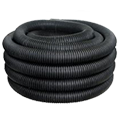Increased yields – A comprehensive twenty year study showed a 29% average increase in corn yields on tiled vs. non-tiled land and a 26% increase in soybean yields. A ten year study performed in Ohio showed a corn yield increase due to drainage of 40 bushels per acre.
- Soil structure improved – Soil needs to be drained to avoid soil compaction and structural damage, both of which reduce yields.
- Plant roots receive enough oxygen to mature properly.
- Soil surface temperatures are increased, which helps seeds germinate.
- Plants roots are grown deeper into the soil so they can absorb more nutrients.
- Since the soil can absorb and store more rainfall, runoff from the soil surface is reduced. Thus, soil erosion is reduced.
- The number of days available for planting and harvesting crops is increased.
- Crop loss due to drowning is decreased and land values are increased.
- Soil bearing strength is increased. The bearing strength of soil depends on its water content which in turn is affected by the depth of the water table. Good soil drainage increases soil strength and reduces damage caused by farming operations.
- Promotes energy-conserving efficient farming practices and facilitates no-till and conservation tillage methods.
- Reduced losses of sediments, phosphorus, ammonium-nitrogen, pesticides, micro-organisms, and anti-biotics.
Summarized Advantages of Tile Drainage:
- More consistent yields
- Allows for more efficient use of resources
- Reduces financial risk
- Earlier and timelier planting
- Improved harvesting conditions
- Less wear and tear on equipment
- Less power required for field operations
- Better plant stand
- Less plant stress
- Fewer plant diseases
- Less soil compaction
- Increased land value
- More efficient water table control
- Complete field farming



 A French drain is a trench filled with gravelor rock or containing a perforated pipe that redirects surface water and groundwater away from an area. A French drain can have perforated hollow pipes along the bottom (see images) to quickly vent water that seeps down through the upper gravel or rock.
A French drain is a trench filled with gravelor rock or containing a perforated pipe that redirects surface water and groundwater away from an area. A French drain can have perforated hollow pipes along the bottom (see images) to quickly vent water that seeps down through the upper gravel or rock. We repair any tile whether it was installed by Bower Tiling Service or another contractor. Tile repair for sink holes, wash outs, animal damage, tree roots, broke down mains, outlet replacements etc.
We repair any tile whether it was installed by Bower Tiling Service or another contractor. Tile repair for sink holes, wash outs, animal damage, tree roots, broke down mains, outlet replacements etc. Structures are intended for low gravity flow. Constructed of rugged 1/2" PVC with lockable plastic lid. Flexible couplers allow PVC, plastic pipe, or other materials to be easily attached. (specify type when ordering) 5 year warranty on all standard structures.
Structures are intended for low gravity flow. Constructed of rugged 1/2" PVC with lockable plastic lid. Flexible couplers allow PVC, plastic pipe, or other materials to be easily attached. (specify type when ordering) 5 year warranty on all standard structures.